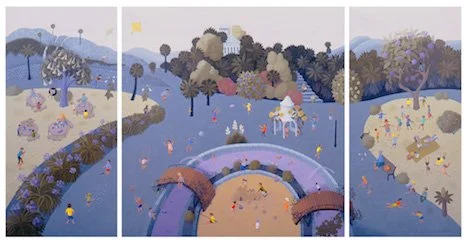David Thomas, ‘Children's Games’, Giclee print essay, 2012
Essay subject:
Children's games, 2006, oil on canvas (triptych), 120.0 x 240.0 cm. Private collection.
Once upon a time there was a beautiful garden where all the children came to play. They were watched over by the good earth mother whose protective presence outlines a mauve path nearby. Agapanthus edge the way. Children fish and swim. They dance around the Jacaranda tree. Others climb its branches festooned with corollas of purple-blues. But not the Angel’s Trumpet tree. Except for a lone boy on a swing, they avoid its branches. For in spite of its superb white flowers and sweetest fragrance, it is poisonous. Even in the Garden of Eden was there a snake.
Created to bring joy to sick children and wise counsel to parents, Anne Marie Graham’s Children’s games, 2006, introduces a fantasy world of the imagination, beguiling in colour, rich in imagery, it pays homage to Pieter Bruegel the Elder’s work of the same name from 1560. As a child in Vienna, Graham was brought up on Breugel, whose paintings are among the treasures of the Künsthistoriches Museum. Responding to his humanity, humour and compositional ideas with a creative flair, she employs the panorama to give a bird’s eye view of this garden of playful delights. Like Breugel, there is no single focus, rather a series of vignettes of games old and new. They share hide-and-seek. But computer games are strictly of our time. Both artists entice us to delve and discover their hidden meanings. Juggling and houses made of cards offer metaphorical comments on life and its uncertainties. Opinions are tested by flying kites. Some grow up to be highflyers. And bubbles blown into the air speak of life’s transient beauty.
Graham elevates games and their meanings to a higher plane by adopting the triptych format. Religious in overtone, it was once the preferred format for altarpieces. The world around us is the springboard for her art, especially involvement with people and plants, embraced by gardens. In her scrutiny of the human condition she peoples views of natural beauty with engaging details, fashioning a bold simplicity of design to catch the eye and lead it into a complex dialogue of ideas. Children’s games are joyous and a serious business. They are the source of creativity and imagination. In later life we seek those wondrous moments of childhood with all its inventive vision. Through Graham’s inspired use of colour and form in Children’s games, we share her explorations of those at play and their deeper meanings. It has a touch of fairy-tale about it – of a dream that will end happily ever after.
David Thomas


